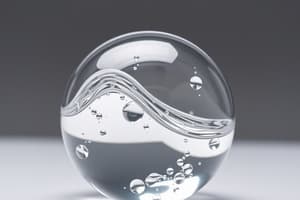Podcast
Questions and Answers
What is the molecular arrangement of a solid?
What is the molecular arrangement of a solid?
Ordered
What is the molecular arrangement of liquids?
What is the molecular arrangement of liquids?
Disordered
What is the molecular arrangement of gas?
What is the molecular arrangement of gas?
Very disordered
Liquids do not flow easily.
Liquids do not flow easily.
Gases flow easily.
Gases flow easily.
What is the volume of solids?
What is the volume of solids?
Are solid easily compressed?
Are solid easily compressed?
Liquids are easily compressed.
Liquids are easily compressed.
Gases are easily compressed.
Gases are easily compressed.
How fast can solids diffuse?
How fast can solids diffuse?
Physical changes in matter happens when intermolecular forces are affected.
Physical changes in matter happens when intermolecular forces are affected.
What are physical properties?
What are physical properties?
Define intensive properties.
Define intensive properties.
An element is a pure substance made up of one type of atom.
An element is a pure substance made up of one type of atom.
Elements are divided into metals and nonmetals.
Elements are divided into metals and nonmetals.
Give an example of nonmetal elements.
Give an example of nonmetal elements.
Define compounds.
Define compounds.
Compounds can be separated physically.
Compounds can be separated physically.
Who drew upon the ancient Greek idea of atoms, stating that atoms are indivisible?
Who drew upon the ancient Greek idea of atoms, stating that atoms are indivisible?
Who discovered electrons?
Who discovered electrons?
Whose experiment involved firing positively charged alpha particles at a thin sheet of gold foil?
Whose experiment involved firing positively charged alpha particles at a thin sheet of gold foil?
Who stated that electrons moved around the nucleus in orbits of fixed sizes and energies?
Who stated that electrons moved around the nucleus in orbits of fixed sizes and energies?
Who stated that electrons do not move in set paths around the nucleus, but in waves?
Who stated that electrons do not move in set paths around the nucleus, but in waves?
What is the charge of an electron?
What is the charge of an electron?
What is the charge of a proton?
What is the charge of a proton?
Define Isotopes.
Define Isotopes.
Flashcards
Solid
Solid
Matter in which atoms or molecules are highly ordered, have a fixed volume and shape, and are not easily compressed.
Liquid
Liquid
Matter in which atoms or molecules are disordered, have a definite volume but no fixed shape, and are not easily compressed.
Gas
Gas
Matter in which atoms or molecules are very disordered, have no fixed volume, and are easily compressed.
Sublimation
Sublimation
Signup and view all the flashcards
Vaporization
Vaporization
Signup and view all the flashcards
Physical Properties
Physical Properties
Signup and view all the flashcards
Chemical Properties
Chemical Properties
Signup and view all the flashcards
Element
Element
Signup and view all the flashcards
Compound
Compound
Signup and view all the flashcards
Isotopes
Isotopes
Signup and view all the flashcards
Study Notes
- Effects of the arrangement and motion of atoms and molecules determines the states of matter.
States of Matter
- Solid: Ordered molecular arrangement, does not flow, has a fixed volume, is easily compressed, and diffuses extremely slowly.
- Liquid: Disordered molecular arrangement, flows easily, has a definite volume, is not easily compressed, and has a slow diffusion rate.
- Gas: Very disordered molecular arrangement, flows easily, has no fixed volume, is not easily compressed, and has a fast diffusion rate.
Physical Changes in Matter
- Occur when intermolecular forces are affected.
Phase Changes in Matter
- Sublimation: Solid to gas.
- Melting: Solid to liquid.
- Vaporization: Liquid to gas.
- Condensation: Gas to liquid.
- Freezing: Liquid to solid.
- Deposition: Gas to solid.
Properties of Matter
- Physical Properties: Observed physically about the substance in its natural state.
- Chemical Properties: Observed when chemical changes occur.
- Intensive Properties: Independent of the amount of substance in a material sample and exist at the molecular level. Examples include flammability, density, and boiling point.
- Extensive Properties: Dependent on the amount of substance in a material sample. Examples include mass, surface area, and volume. Density is derived from the ration of mass and volume.
Chemical Properties
- Chemical Change Examples: Indicate that one or more substances form a new substance. Examples include burning wood, rotting fruit, baking a cake, rusting metal, using a battery, digestion, souring milk, exploding fireworks, cooking an egg, and photosynthesis.
Element
- A pure substance made of one type of atom.
- Elements are divided into metals and non-metals.
- Non-metal examples: carbon, oxygen, hydrogen, and nitrogen.
- Metal examples: aluminum, iron, copper, and gold.
Compound
- A substance made up of atoms of two or more different elements joined by chemical bonds.
- Compounds cannot be separated physically.
- Example of a compound: H2O.
History of the Atom: Theories and Models
- John Dalton (1803): Atoms of a particular element differ from other elements.
- J.J. Thomson (1904): Recognized electrons as components of atoms. Plum pudding model that shows the atom as composed of electrons scattered throughout a spherical cloud of positive charge.
- Ernest Rutherford (1911): Realized positive charge was localized in the nucleus of an atom.
- Niels Bohr (1913): Proposed stable electron orbits and explained the emission spectra of some elements.
- Erwin Schrödinger (1926): Electrons do not move around the nucleus in orbits, but in clouds where their position is uncertain.
Parts of an Atom
- Proton: Positive electrical charge.
- Neutron: Neutral charge.
- Electron: Negative electrical charge
Particle Properties
- Electron: Negative charge, mass of 5.486 x 10-24 amu.
- Proton: Positive charge, mass of 1.0073 amu.
- Neutron: Neutral charge, mass of 1.0087 amu.
Mass Number and Atomic Number
- Mass number is the number of protons + number of neutrons.
- Atomic number is the number of protons.
Isotopes
- A variation of an element with the same atomic number but a different mass number.
Isotopes of Hydrogen
- Protium (¹H): 1 proton, 1 electron, 0 neutrons, mass number of 1.
- Deuterium (²H): 1 proton, 1 electron, 1 neutron, mass number of 2.
- Tritium (³H): 1 proton, 1 electron, 2 neutrons, mass number of 3.
Isotopes of Carbon
- Carbon-12: 98.9%, 6 protons, 6 neutrons.
- Carbon-13: 1.1%, 6 protons, 7 neutrons.
- Carbon-14: <0.1%, 6 protons, 8 neutrons.
Uses of Isotopes in Research
- Carbon-14: Carbon dating in archeology and research involved in plant photosynthesis.
- Phosphorus-32 & Phosphorus-33: Research involving biology and genetics.
- Selenium-75: Protein studies in life science.
- Strontium-85: Metabolism and bone formation studies.
- Hydrogen-3 or Tritium: Study life science and drug metabolism.
Electron Configuration
- Describes how electrons are distributed in atomic orbitals.
- Notation: All electron-containing atomic subshells are placed in a sequence.
Studying That Suits You
Use AI to generate personalized quizzes and flashcards to suit your learning preferences.




